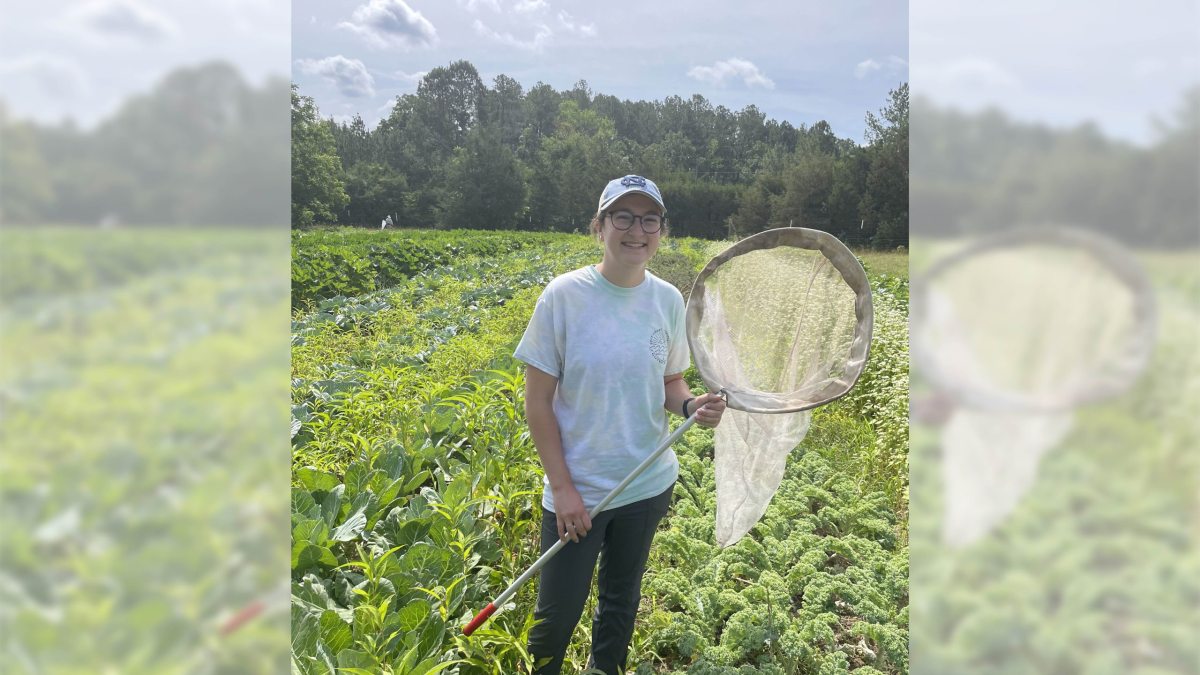Carolina junior studies how climate change might disrupt butterfly life cycles
Madison Milotte used a Summer Undergraduate Research Fellowship to study how increasing temperatures affect the pupation of cabbage white butterflies.

Eleven miles from Carolina, junior Madison Milotte wears a Carolina baseball cap to block the sun and walks through rows of organic greens on Perry-winkle Farm in Chatham County.
It is a gorgeous landscape: sprawling fields filled with lush crops and flowers. But Milotte, who uses they/them pronouns, isn’t there to harvest the farm’s cabbage and kale.
They are there — net in hand — to search for cabbage white butterflies, the subject of their Summer Undergraduate Research Fellowship project, an initiative of the College of Arts and Sciences’ Office of Undergraduate Research.
Why Carolina
Milotte, a Chancellor’s Science Scholar, chose Carolina with the goal of conducting research as an undergraduate student.
“Since my first year of high school, I’ve always wanted to study biology,” said Milotte, an environmental sciences and biology double major. “And when looking at biology research, Carolina had exceptional professors and access to the research that I was most interested in doing.”
With a passion for ecology and evolutionary biology, Milotte joined the Joel Kingsolver lab before they finished their first year at Carolina.
In the Kingsolver lab, Milotte worked with fellow researchers to answer the question: How do organisms respond and adapt to complex, variable natural environments?
It was a chance to gain hands-on experience in the field and valuable hours in the lab. And, after about a year, Milotte was ready to put their experience to the test with their own research project.
SURF’s up
“It’s well known, with caterpillars and other insects, that there are curves that exist” in their development, Milotte explained in their research hypothesis.
This curve is visualized when data on the insects’ development is plotted on a graph in relation to outdoor temperatures. When temperatures are cold, caterpillars go through development slowly. As temperatures warm, their development ramps up. And then, as the weather gets hotter, the process starts to slow again.
In the case of cabbage white butterflies, Milotte had an idea of what to expect based on these trends. However, they needed first-hand research to prove that the butterflies would follow the same developmental curves as other insects.
“We wanted to precisely figure out that curve using modeling so that we could predict more accurately what’s going to happen in regard to climate change,” they said.
Their research started with field work — literally. Milotte and their lab worked to find and make relationships with farmers who were already growing crops — without the use of pesticides — that attracted the butterflies.
“The farms had to have cabbage and kale,” Milotte said. “Those are the things cabbage white butterflies really go for.”
Once the butterflies were caught, Milotte fed them collard greens and coaxed them to lay eggs on flowers crafted from construction paper and honey-water-filled test tubes.
“I ended up with way more eggs than I needed. It was very successful,” they said.
When the eggs began to hatch, it was time to measure larval growth at different temperatures, one caterpillar at a time.
“We measured each individual caterpillar every day,” they said. “At one point, I probably had at least 200 dishes.” Only after all these steps could Milotte begin collecting data on temperature and pupation (when the caterpillar forms a chrysalis to become a butterfly), the ultimate goal of the study.
The caterpillars were divided into five temperature chambers — ranging from 16 degrees Celsius (about 60 degrees Fahrenheit) to 34 degrees Celsius (about 93 degrees Fahrenheit) — to help Milotte understand the full effects of changing temperature on the caterpillars’ development.
When the butterflies emerged, Milotte was thrilled: their results matched the predicted curves exactly.
“‘We did it!’” Milotte remembers saying to their mentor, biology Ph.D. student Anna Parker, upon seeing the data on their graph. “It was definitely an exciting moment.”
Lasting impact
Throughout the research process, Milotte gained valuable insight in their field.
They adapted when they ran into complications in the pupation period for some of the caterpillars and worked to test new diet ideas to determine the best way forward. They got the chance to work with other researchers closely and gained confidence as they answered Kingsolver’s questions about the study’s methods.
But Milotte’s favorite part of the experience was the leadership skills they gained during the project.
“For the first time in my lab, I got to feel like an expert at something,” they said. “And, as an undergraduate student, having that expertise is really empowering.”
This semester, Milotte is taking a hiatus from the Kingsolver lab to study at the UNC Institute of Marine Sciences in Morehead City. When they return to Chapel Hill next semester, they will begin work on their honors thesis, which will be focused on cabbage white butterflies, too.




